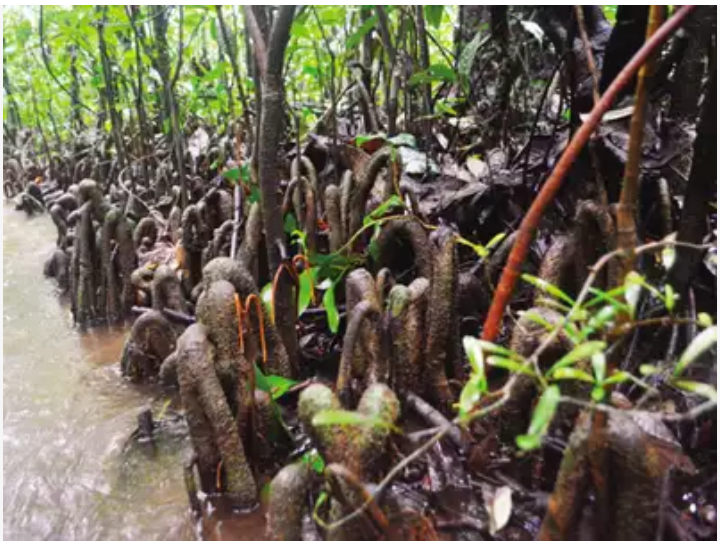Description

Disclaimer: Copyright infringement not intended.
Context
- Myristica swamps, remnants of forest vegetation, are found in the sacred groves of Kerala.
- The 55-acre Kammadam Kavu, a home to a Myristica swamp over 2-3 acres, is the largest grove in Kerala.
- This swamp holds special significance as it has five small streams of water flowing into the Kariangode Puzha or river in Kasargod.
More about Myristica swamps
- These are a type of freshwater swamp forest predominantly composed of species of Myristica.
- In India these are mainly located in the Karnataka State (Uttara Kannada district), in the southern parts of Kerala and in in Maharashtra (Sindhudurga district).
- These swamps harbour endemic and endangered plant species which are valuable for their medicinal properties.
- These are generally found inside a forest near freshwater areas, evergreen forest patches and are included in the littoral and swamp forest groups.
- These swamps support a unique biodiversity however these ecosystem has very limited extent and distribution and there is an urgent need for protection.
- Species of Myristica has stilt roots/ knee roots to breathe.
|
Biodiversity
Also called biological diversity, it refers to the variety or richness of ecosystems variety of life forms (flora, fauna) and their interconnections with each other and the environment.
Hence it is the number and varieties of plants, animals and micro-organisms found within a specified geographic region.
|
|
Stilt Roots
It is a tree root that pop up above the water level arising from the lower trunk and runs obliquely to the ground. Hence it provides additional support for the tree.
|
Biodiversity in Myristica swamps
- Amphibians like Frogs, toads and caecilians are found in these swamps.
- These support various kinds of fresh water fish.
- These are believed to be the Home to various endemic plants of the Western Ghats.
- For instance Myristica malabarica is closely associated with nutmeg. Myristica fatue, is a rare plant, which have a population of less than 20 trees in Kerala.
- They support a vulnerable species, as listed in IUCN Red Data book, Syzygium travencuricum.
- Hence they serve as good regenerative patches for flourishing of these specific species as these areas have specific waterlogged conditions and conducive soil properties.
|
Endemic
It refers to the Biological species, plant and animal species, that have a restricted distribution and are only found in a certain geographical area. For instance Gir National Park and Wildlife Sanctuary is the only abode of the Asiatic lion.
|
Threats
- Survival threats these natural habitats are facing include drying up of fresh water bodies, climate change and increasing human interference.
- Most responsible factor is construction industry which accounts for 40% of overall habitat destruction.
- Mismanagement and pollution of rivers.
- Invasion of semi-evergreen and deciduous species for instance legumes, white dammer, terminalia and woody climbers.
Sacred grove
- Sacred groves hold religious and cultural significance for many tribals.
- These are the tracts of forest which are set aside, and all the trees and wildlife within were venerated and totally protected.
- Considered sacred, trees in these groves are worshiped and left undisturbed by the local tribal groups.
- Such sacred groves are found in many regions of India. Some of them are Khasi and Jaintia Hills in Meghalaya, Aravalli Hills in Rajasthan, Western Ghat regions of Karnataka and Maharashtra Bastar areas of Madhya Pradesh etc.
Significance of Sacred grove
- Strengthen ties with indigenous rituals and religion hence helps in protection of culture.
- They act as a storehouse of various plant species useful for their medicinal properties.
- Keeping nature undisturbed helps in protection of forest and associated Biodiversity.
- They also serve as the refuse for a large number of other rare, unique, indigenous and threatened plants and animal species. Hence aiding in their preservation.
- These also help in creating awareness about biodiversity conservation.
|
PRACTICE QUESTION
Preservation of sacred groves is considered significant for a flourishing Biodiversity. Elaborate.
Also enumerate the challenges posed in the protection of these sacred groves. (150 words)
|

https://www.thehindu.com/life-and-style/climate-change-and-human-intervention-threaten-the-myristica-swamps-of-kerala/article66896954.ece
https://www.oxfordreference.com/display/10.1093/oi/authority.20110803100533184;jsessionid=FE3A95F344D71B9745D1259A693984CB
https://www.thehindu.com/opinion/op-ed/biodiversity-is-us-and-we-are-biodiversity/article66916822.ece
https://ncert.nic.in/textbook/pdf/lebo115.pdf
https://www.biologyonline.com/dictionary/endemic
http://www.botanydictionary.org/endemic.html
https://www.wwfindia.org/about_wwf/priority_species/threatened_species/asiatic_lion/#:~:text=At%20present%20Gir%20National%20Park,of%20Saurashtra%20region%20of%20Gujarat.












